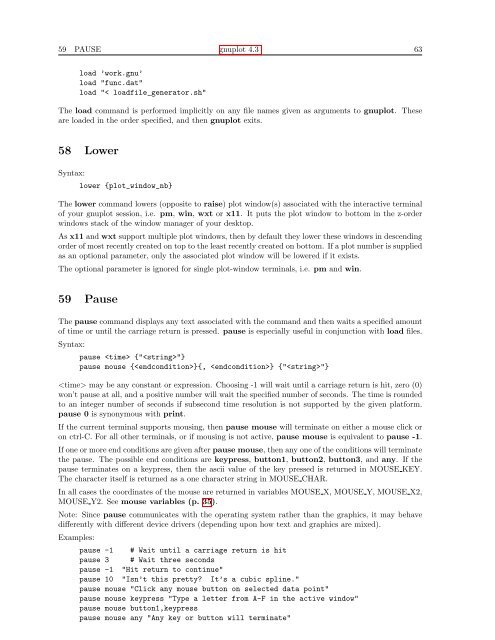gnuplot documentation
gnuplot documentation
gnuplot documentation
You also want an ePaper? Increase the reach of your titles
YUMPU automatically turns print PDFs into web optimized ePapers that Google loves.
59 PAUSE <strong>gnuplot</strong> 4.3 63<br />
load ’work.gnu’<br />
load "func.dat"<br />
load "< loadfile_generator.sh"<br />
The load command is performed implicitly on any file names given as arguments to <strong>gnuplot</strong>. These<br />
are loaded in the order specified, and then <strong>gnuplot</strong> exits.<br />
58 Lower<br />
Syntax:<br />
lower {plot_window_nb}<br />
The lower command lowers (opposite to raise) plot window(s) associated with the interactive terminal<br />
of your <strong>gnuplot</strong> session, i.e. pm, win, wxt or x11. It puts the plot window to bottom in the z-order<br />
windows stack of the window manager of your desktop.<br />
As x11 and wxt support multiple plot windows, then by default they lower these windows in descending<br />
order of most recently created on top to the least recently created on bottom. If a plot number is supplied<br />
as an optional parameter, only the associated plot window will be lowered if it exists.<br />
The optional parameter is ignored for single plot-window terminals, i.e. pm and win.<br />
59 Pause<br />
The pause command displays any text associated with the command and then waits a specified amount<br />
of time or until the carriage return is pressed. pause is especially useful in conjunction with load files.<br />
Syntax:<br />
pause {""}<br />
pause mouse {}{, } {""}<br />
may be any constant or expression. Choosing -1 will wait until a carriage return is hit, zero (0)<br />
won’t pause at all, and a positive number will wait the specified number of seconds. The time is rounded<br />
to an integer number of seconds if subsecond time resolution is not supported by the given platform.<br />
pause 0 is synonymous with print.<br />
If the current terminal supports mousing, then pause mouse will terminate on either a mouse click or<br />
on ctrl-C. For all other terminals, or if mousing is not active, pause mouse is equivalent to pause -1.<br />
If one or more end conditions are given after pause mouse, then any one of the conditions will terminate<br />
the pause. The possible end conditions are keypress, button1, button2, button3, and any. If the<br />
pause terminates on a keypress, then the ascii value of the key pressed is returned in MOUSE KEY.<br />
The character itself is returned as a one character string in MOUSE CHAR.<br />
In all cases the coordinates of the mouse are returned in variables MOUSE X, MOUSE Y, MOUSE X2,<br />
MOUSE Y2. See mouse variables (p. 35).<br />
Note: Since pause communicates with the operating system rather than the graphics, it may behave<br />
differently with different device drivers (depending upon how text and graphics are mixed).<br />
Examples:<br />
pause -1 # Wait until a carriage return is hit<br />
pause 3 # Wait three seconds<br />
pause -1 "Hit return to continue"<br />
pause 10 "Isn’t this pretty? It’s a cubic spline."<br />
pause mouse "Click any mouse button on selected data point"<br />
pause mouse keypress "Type a letter from A-F in the active window"<br />
pause mouse button1,keypress<br />
pause mouse any "Any key or button will terminate"

















